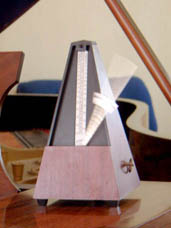Word of the Day
LENTO (LEN-toh)
A slow tempo in music
Common clues: Slowly, in music; Slow movement
Crossword puzzle frequency: once a year
Video: Walter Piston’s Three Pieces for Wind, Movement 2: Lento
In musical terminology, tempo (Italian for "time") is the speed or pace of a given piece. It is an extremely crucial element of sound, as it can affect the mood and difficulty of a piece.
The tempo of a piece will typically be written at the start of a piece of music, and in modern music is usually indicated in beats per minute (BPM). This means that a particular note value (for example, a quarter note or crotchet) is specified as the beat, and the marking indicates that a certain number of these beats must be played per minute.

Mathematical tempo markings of this kind became increasingly popular during the first half of the 19th century, after the metronome had been invented, although early metronomes were somewhat unreliable; Beethoven's metronome markings, in particular, are notoriously unreliable. MIDI files today also use the BPM system to denote tempo.
Some 20th century composers (such as Béla Bartók and John Cage) would alternatively give the total execution time of a piece, from which the proper tempo can be roughly derived.
Whether a music piece has a mathematical time indication or not, in classical music it is customary to describe the tempo of a piece by one or more words. Most of these words are Italian, a result of the fact that many of the most important composers of the 17th century were Italian, and this period was when tempo indications were used extensively for the first time.
Before the metronome, words were the only way to describe the tempo of a composition. Yet after the metronome's invention, these words continued to be used, often additionally indicating the mood of the piece, thus blurring the traditional distinction between tempo and mood indicators. For example, presto and allegro both indicate a speedy execution (presto being faster), but allegro also connotes joy (from its original meaning in Italian). Presto, on the other hand, indicates speed as such (while possibly connoting virtuosity, a connotation it did not acquire until the late 18th century).
The most common tempo markings in Italian are:
Grave - very slowly and almost solemn
Largo - slowly and broadly
Lento - "slow" but usually only moderately so
Adagio - slowly
Andante - at a walking pace
Moderato - at a moderate tempo, neither fast nor slow
Allegretto - "a little allegro", understood to be not quite as fast as allegro
Allegro - quickly
Vivace - very fast, lively and brisk
Presto - fast
Prestissimo - very, very fast.
This article is licensed under the GNU Free Documentation License. It uses material from the Wikipedia article "Tempo".
|
|